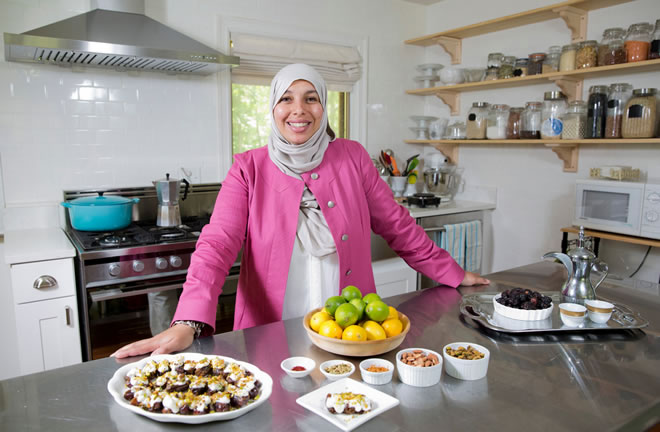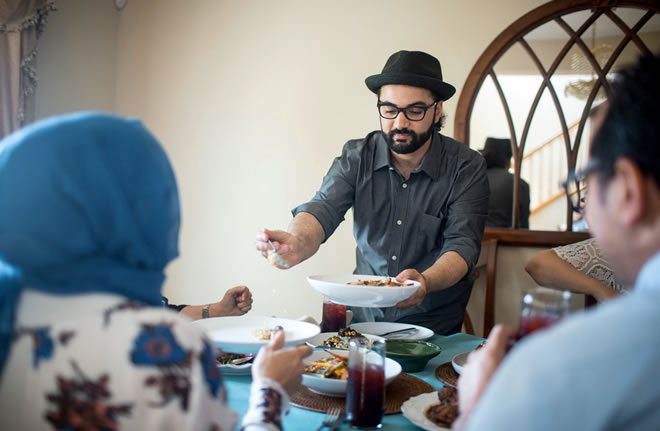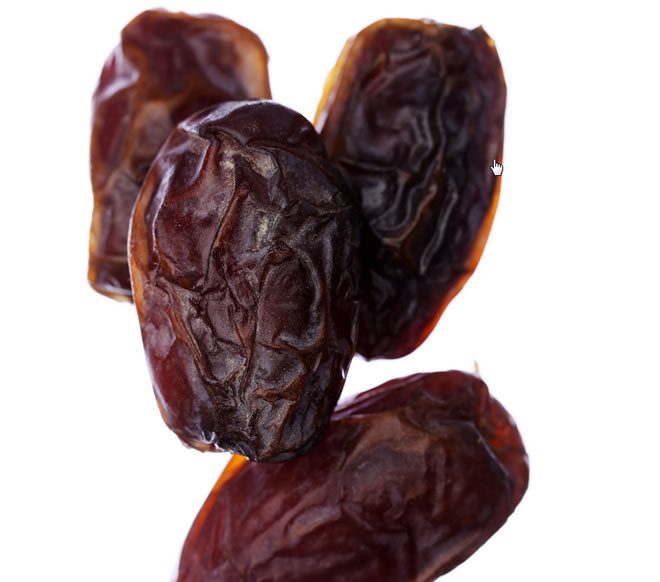
By JULIA MOSKIN
Thursday, June 18, 2015

Yvonne Maffei Credit Nathan Weber for The New York Times
When the chef Sameh Wadi was growing up — first in Kuwait, then in Jordan, and finally in Minneapolis and St. Paul — one of the few constants in his life was his mother’s cooking, especially the date-filled ring cookies called ka’ak that she made by hand and stockpiled during Ramadan.
Children do not fast during Ramadan, but adults like Mr. Wadi’s mother, Shahira, do not eat during daylight for the month. Traditionally, women spend much of their time cooking for the iftar, or fast-breaking meal, that is eaten every night after sunset.
“No question, those are my favorite things in the world to eat,” Mr. Wadi said. “I never realized as a kid how cruel it was to steal them, because even though she was fasting, she would still have to make more.
During Ramadan, the far-flung Muslim communities of the world are unified by one food: the date, one of the earliest cultivated crops and an ancient icon of the Middle East, where the thick-trunked date palm is a symbol of hospitality, rest and peace.
In the hadith, a collection of sayings attributed to the prophet Mohammed, it is recorded that he always broke the fast with dates and water, so many Muslims are careful to follow, whether the fruit is called balah (Arabic), khajoor (Urdu), hurmah (Turkish) or buah tanggal (Indonesian).
In modern communities, restaurants offer iftar specials and buffets, and all-night food markets pop up to feed the hungry throngs. Dates are always available, out of respect for tradition and because they provide a quick boost of energy for the eating to come.
“An iftar without dates would feel very strange to all the Muslims I know,” said Yvonne Maffei, who writes a popular cooking and nutrition blog, My Halal Kitchen, from her home north of Chicago. “It would be like Thanksgiving without a turkey: The table doesn’t look right without it.”
This year, each day’s fast will be a particularly long one in much of the United States, from about 5 a.m. to 8:30 p.m., as Ramadan begins on the evening of June 17. (Because the Islamic calendar is lunar, not solar, Ramadan takes place at different times during the Western year.)
Cooking for Ramadan seems like an oxymoron, but the two large meals of the night hours, the predawn suhoor and the sundown iftar, are opportunities for home cooks to come up with ever more alluring, filling and nourishing dishes.
“It sounds strange that Ramadan is a time for even thinking more about food,” said Razia Parvez, a homemaker in Boonton, N.J., who was born in Pakistan. “But cooking helps me get through the fast, because I can smell everything and imagine the tastes that I will be serving my family later.”

Sameh Wadi Credit Jenn Ackerman for The New York Times
Muslims observing the fast try to eat extra dairy and protein at both meals to help stave off hunger the following day. Iftar invariably includes a bowl of dates, and sometimes more elaborate desserts, like pitted dates stuffed with nuts or labne (thick yogurt); ma’moul and ka’ak, round cookies filled with dates; and date paste rolled into cylinders or balls and coated with coconut.
The most elaborate desserts are saved for Eid al-Fitr, a great feast on the first night of the month that follows Ramadan, which this year falls on July 17. Shirin Farhat, an Iranian-American student in Los Angeles, said that her mother’s ranginak, a traditional Persian cake of dates cooked with cinnamon and cardamom and layered with walnuts, is the dish she looks forward to all year long. “I just take a bite of a date to break the fast,” she said. “I save my appetite for ranginak.”
There are three basic types of dates: soft (including barhi, halawi, khadrawi and medjool), semi-dry (like the deglet noor and zahidi), and dry (like thoori), but thousands of variations are available around the world. Their flavors range from rich molasses to light butterscotch to honey, sometimes accented with the headiness of cognac, the succulence of prunes and the burnt-sugar edge of caramel.
They are mentioned often in the Quran, the Bible and ancient Sumerian and Assyrian texts. Like all palm trees, date palms belong in the same botanical family as grasses, not fruits; that’s why, nutritionally speaking, they have more in common with grains than with most fruits. Dates contain potassium, protein, iron and other minerals; they can last for years and thus have been staples of the diet of nomadic people all over the Middle East for centuries.
Date palms from the Middle East began arriving in the United States about 100 years ago, when the Department of Agriculture began its effort to transform the arid regions of the Southwest into fruitful fields.
Along with almonds, oranges, lemons and figs, dates are a drought-resistant crop that can flourish in desert conditions, and California’s Coachella Valley and the area around Yuma, Ariz., have proved ideal. (In that region, water for irrigation arrives via canals from the Colorado River, so the drought affecting Central and Northern California, which draw their water from the state’s northern mountain regions, is not as threatening.)

Medjool dates. Credit Tony Cenicola/The New York Times
Robert Lower, the owner of Flying Disc Ranch in Thermal, Calif., has been growing dates and other fruits in the Coachella Valley since 1974. “I was looking for something no one else was growing,” Mr. Lower said. At the time, he said, the demand for dates had declined as other sources of sugar became plentiful. But over the years, with the growth of the Arab-American communities in Southern California and a rising awareness of the health benefits of dates, he now sells all the dates he can grow.
But the khalal date season is very short: They are available from California and Arizona only for a few weeks of the year.
More and more of Mr. Lower’s customers at farmers’ markets, he said, are asking for barhi dates, one of the few types that can be eaten in its yellow unripe stage (called khalal in Arabic; fully ripe, tree-dried dates are tamar, meaning sweet). Mourad Lahlou, the chef at Mourad in San Francisco, grew up in Morocco and deploys khalal dates in the kitchen whenever he can get them. “When they are young, they are crunchy and only slightly sweet, with a hint of astringency,” he said, like a tart grape or crisp apple, making them great for balancing rich and savory dishes.
Mr. Lower uses traditional methods for hand-pollinating, pruning and ripening, and has gradually developed an ecosystem on his ranch that’s almost identical to that of the desert oases of the ancient Middle East. His 450 date palms are planted in precisely measured rows: their huge spreading leaves form a canopy of shade that shelters the citrus, fig and pomegranate trees underneath.
Despite the rise of interest that Mr. Lower has seen, dates have never caught on as a fruit to eat out of hand in the United States. This may be because the type of date most commonly grown in the United States, the deglet noor, is better known for its hardiness than for its flavor.
Ms. Maffei of My Halal Kitchen, who was raised in Catholic household in Ohio and converted to Islam in her 20s, grew up with dates at Christmas. “You would always have them on the plate with the candied fruit and the red pistachios, and no one ever ate them,” Ms. Maffei said. But, she said, when she began to observe Ramadan, her mind was changed by the rich flavor and plump texture of medjool dates. Her simple recipe for medjools drizzled with tangy crème fraîche is excellent for transforming date doubters into date lovers.
Deglet noors hold up well when cooked in chutneys, desserts or Moroccan tagines and pilafs, like the one Ms. Maffei makes with a whole roast chicken and fluffy couscous that absorbs the sweetness of dates and the butteriness of toasted almonds.
Though Mr. Wadi serves some of his mother’s recipes at his restaurantSaffron in Minneapolis (“I can’t bring myself to change them,” he said), he believes that many of the traditional ingredients of the Middle East are now ripe for reinvention. For example, dates would rarely be used in a savory dish like his wheat berries with roasted carrots and spicy yogurt, a combination of yogurt and North African harissa that is itself rather revolutionary.
During Ramadan, many Muslim-Americans make a point of seeking out dates from their ancestors’ home countries: the red-brown zaghloul from Egypt, golden barhis from Iraq, orange-brown sair dates from Iran. Throughout the Muslim world, purple-black ajwa dates from Medina in Saudi Arabia, where the prophet lived and died, are considered the finest of all.
They hardly ever make it to the United States, but Mr. Wadi got his hands on some recently. “I just sat down and ate them all,” he said. “Cooking an ajwa would be like deep-frying a black truffle.”
Recipes: Dates With Cream and Chopped Pistachios | Wheat Berries With Roasted Carrots, Harissa Yogurt and Dates | Roast Chicken With Couscous, Dates and Buttered Almonds |Cucumber Yogurt Salad With Dill, Sour Cherries and Rose Petals | Lamb Shanks With Pomegranate and Saffron | More Foods to Break the Fast